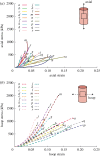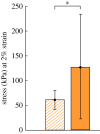Inflation and rupture of vaginal tissue
- PMID: 31263539
- PMCID: PMC6597515
- DOI: 10.1098/rsfs.2019.0029
Inflation and rupture of vaginal tissue
Abstract
Around 80% of women experience vaginal tears during labour when the diameter of the vagina must increase to allow the passage of a full-term baby. Current techniques for evaluating vaginal tears are qualitative and often lead to an incorrect diagnosis and inadequate treatment, severely compromising the quality of life of women. In order to characterize the failure properties of the vaginal tissue, whole vaginal tracts from rats (n = 18) were subjected to free-extension inflation tests until rupture using a custom-built experimental set-up. The resulting deformations were measured using the digital image correlation technique. Overall, the strain and changes in curvature in the hoop direction were significantly larger relative to the axial direction. At a failure pressure of 110 ± 23 kPa (mean ± s.d.), the hoop and axial stresses were computed to be 970 ± 340 kPa and 490 ± 170 kPa, respectively. Moreover, at such pressure, the hoop and axial strains were found to be and , respectively. Rupture of the vaginal specimens always occurred in the hoop direction by tearing along the axial direction. This knowledge about the rupture properties of the vaginal tissue will be crucial for the development of clinical approaches for preventing and mitigating vaginal tearing and the associated short- and long-term traumatic conditions.
Keywords: elasticity; inflation; rupture; vagina.
Conflict of interest statement
We declare we have no competing interests.
Figures










References
LinkOut - more resources
Full Text Sources
